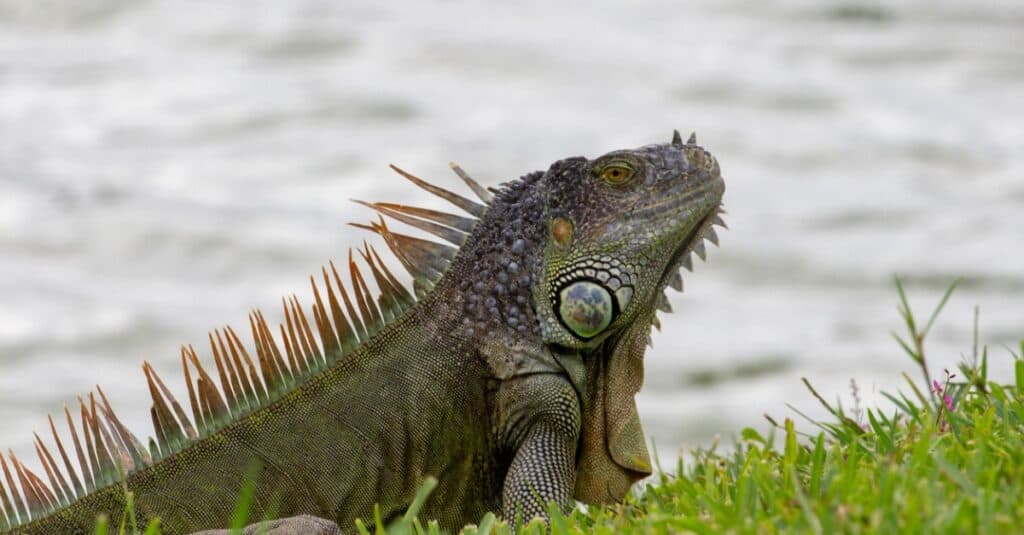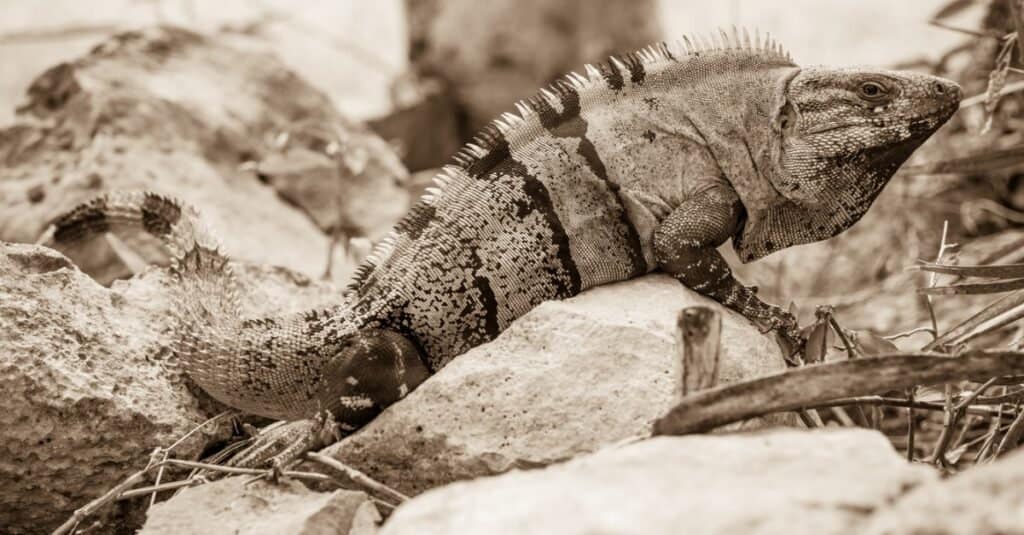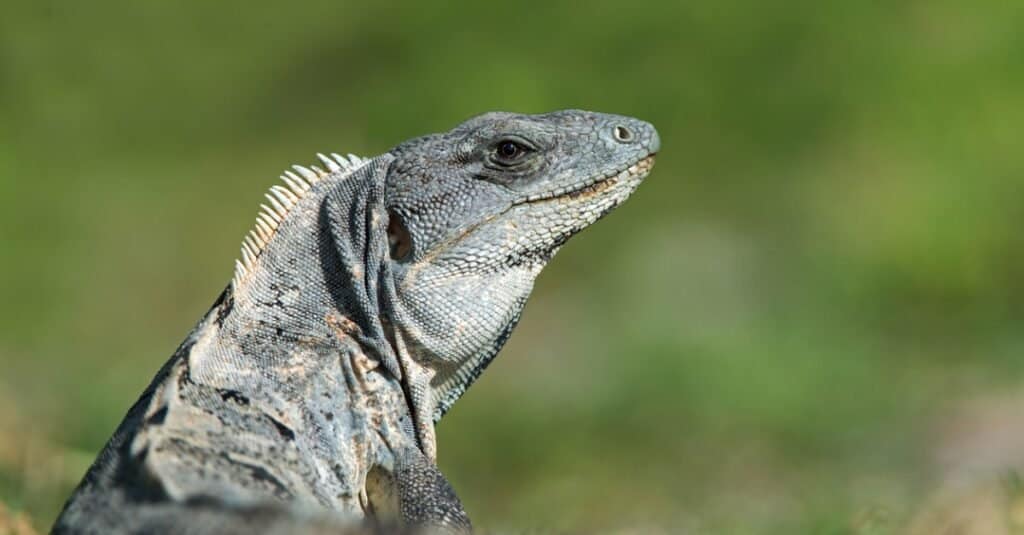While most areas in the United States are more temperate and don’t make great homes for most species of iguana, Florida is something of an anomaly.
Since its subtropical climate makes it warm and humid year-round, Florida has become an ideal home to many species of reptiles, amphibians, and other animals we normally see in distant, isolated rainforests and on tropical islands. But what iguanas in Florida are actually native to the area? Additionally, are there any invasive species?
Let’s take an in-depth look at the types of Florida iguana living in the famous Sunshine State! We’ll also cover the history of how they got there, why they thrive so well in Florida, and what effects they’ve had on other local wildlife.
Are Any Iguanas Native To Florida?

None of the iguanas found in Florida are native.
©iStock.com/Stacie Acevedo
Interestingly, every species of iguana are invasive. There are no iguana species that are actually native to Florida. Instead, the three main species currently living throughout the state are invasive species. Humans brought these lizards to Florida from nearby islands via cargo ships and independent releases throughout the 1960s and 1970s. Eventually, their populations exploded to uncountable numbers of invasive iguana. Florida just happens to be an ideal environment for iguanas, with its warm, humid weather and diverse plant and animal life for the massive lizards to feed on.
Florida’s three main invasive iguana species are the black spiny-tailed iguana, the Mexican spiny-tailed iguana, and, of course, the green iguana. Florida is not a native habitat for any of them. However, over time, they’ve all become misunderstood yet highly invasive nuisances, wreaking havoc on the state’s plant and animal life and causing serious damage to both man-made and natural structures with their feces and elaborate burrows.
As we look at each of these species in a bit more detail, we’ll be able to understand why they are so damaging to Florida’s ecosystems, exactly how each one was introduced to the area, and what sort of measures state officials are taking to reverse the lizards’ environmental impact as humanely as possible.
Florida Iguana: Mexican Spiny-Tailed Iguanas

The Mexican spiny-tailed iguana was introduced into Florida in the 1970s.
©iStock.com/Cuadro Veinte
One of Florida’s most widespread iguana species is the Mexican spiny-tailed iguana. As you might have guessed, the species is originally native to western Mexico and parts of Central America. Nowadays, it also now inhabits much of South and Central Florida.
These large, brownish-grey lizards partially get their name from the rows of short, rough spines on their tails. The typical Mexican spiny-tailed iguana grows to be between 4 and 5 feet long and weighs between 5 and 15 pounds. Notably, these iguanas are opportunistic omnivores. Although they prefer eating plants, they sometimes also eat insects, small bird and reptile eggs, and even other lizards.
Local environmental scientists believe this iguana was introduced to South Florida mostly via independent releases in the 1970s. Basically, a small number of irresponsible reptile owners released a few of their own iguanas into the wild, and the rest was history.
Over time, those few independently released iguanas reproduced with one another. This resulted in a fast and significant uptick in their numbers. By the time Florida’s environmental agencies could intervene, there were thousands of the lizards living throughout multiple counties.
Mexican spiny-tailed iguanas are especially prolific breeders. Females of the species are able to produce several clutches after a single successful copulation. In fact, each individual clutch usually consists of over 45 eggs!
In more recent years, Florida’s officials have taken various measures to decrease the Mexican spiny-tailed iguana’s numbers. These include introducing predator species to incentivizing the culling of the lizards and even using their meat for food.
Florida Iguana: Black Spiny-Tailed Iguanas

The black spiny-tailed iguana became invasive to Florida in 1978
©iStock.com/davemhuntphotography
Another variety of spiny-tailed iguana that has become a nuisance to Florida’s residents and wildlife is the black spiny-tailed iguana. Although it isn’t a native species, it certainly has established itself in massive numbers throughout the state. Like the Mexican spiny-tailed iguana, a few isolated independent releases introduced these lizards to South Florida back in 1978.
The species is originally native to parts of Mexico, Central America, and a few islands in the Caribbean. They are large, stocky iguanas that are mostly grey or black in color with long, spined tails and long snouts. Most individuals have some vertical grey and black striping across their bellies and tails. Like most spiny-tailed iguana species, these lizards often reach 5+ feet in length and can weigh 10+ pounds as adults!
Because they are such opportunistic omnivores, black spiny-tailed iguanas are damaging to both native plants and animals. They indiscriminately eat any plant material they can get their claws on. This includes not only various shoots, leaves, and vines but also tropical fruit and vegetable crops. But that’s not all! They also enjoy eating insects and arachnids, eggs from all types of birds and reptiles, and occasionally even other lizards.
These particular spiny-tailed iguanas also cause significant damage to buildings and other man-made and natural structures with their large, elaborate burrows. They can dig surprisingly quickly with their long claws and muscular limbs, and their feces and urine create quite a mess in the process.
Like with the Mexican spiny-tailed iguana, various measures have been taken by Florida’s government and environmental agencies to diminish the species’ population. However, these persistent iguanas still remain numerous today, with their numbers reaching well into the tens of thousands.
Iguanas in Florida: Green Iguanas

Green iguanas were introduced into Florida in the 1960s
©iStock.com/passion4nature
Finally, we’ve come to the most widespread iguana species in Florida by far–the majestic and docile yet tragically destructive green iguana. Although many Floridians mistakenly believe green iguanas are native to the state, the species is actually highly invasive.
These large, handsome lizards are easily recognizable due to their vibrant green (and sometimes red, orange, and blue) coloration, tall spikes extending down their spines, and outgoing, friendly temperaments. They start out small as babies but quickly explode in size. Adult green iguanas commonly reach 5+ feet in length and can weigh over 15 pounds!
It certainly seems like iguanas have existed in Florida for centuries due to their massive numbers. However, they’ve actually only existed in the Sunshine State since the mid-1960s. Florida’s first green iguanas likely hitched a ride on Cuban cargo ships transporting goods to Florida in the 1960s.
Soon after their arrival, the herbivorous lizards reproduced rapidly and established themselves throughout South and Central Florida. They indiscriminately began feeding on all manner of both widespread and endangered plants in the state, in turn also disturbing various native wildlife populations. Researchers have even observed the iguanas hijacking other animals’ burrows, such as the native burrowing owl and gopher tortoise.
Today, green iguanas are everywhere throughout the state, even in northern Florida where temperatures are cooler. Notably, climate change has resulted in far fewer cold spells than usual. As a result, the iguanas aren’t dying off in large numbers in the winter like they did in the 1970s and ‘80s.
Although the state has since incentivized the culling of green iguanas and using them for meat, the persistent species’ numbers continue to grow. Like the other two iguana species mentioned above, green iguanas are extremely prolific breeders. In fact, they are capable of laying massive clutches of 40+ eggs at a time. Currently, researchers estimate there are well over 20,000 green iguanas living in Florida.
The photo featured at the top of this post is © iStock.com/passion4nature
FAQs (Frequently Asked Questions)
What is the largest iguana species in Florida?
The largest iguana species you’re likely to spot in Florida is the green iguana. The largest green iguanas on record can reach up to 20 pounds!
Thank you for reading! Have some feedback for us? Contact the AZ Animals editorial team.







